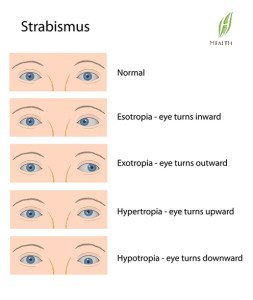Amblyopia
Amblyopia ( Lazy eye ) is the medical term to describe the vision of one eye (sometime both eyes) that do not reach the normal vision standard without pathological reason. It occurs when one eye is more nearsighted, more farsighted or more astigmatic than the fellow eyes. This affected eye has poor connection with the brain, which leads to underdevelopment of the related area in the brain in the childhood. Children with amblyopia may not beware of the vision problem as they can see pretty well with the fellow eye. Most of the amblyopia are treatable when they are detected in an early age (before age of 8), by means of glasses, occlusion treatment and visual training. It can be caused by strabismus as well.
Strabismus
It is a visual condition which a person cannot align both eyes properly at a point in different distances. The problem can be affected when looking at near, at distant or both. One eye may look straight ahead, towards the target, while the other eye turns to another direction. It can be due to the intra-ocular muscles imbalance when looking at different gazes or distances. Sometimes, uncorrected farsightedness, cataract patients and some neurological disorders can result in strabismus. Binocular vision will be affected and amblyopia will occur for no early diagnosis and timely treatment. Eyeglasses, vision training and surgery will be considered in different cases.
Pseudo strabismus
Pseudo strabismus generally occurs in infants and toddlers, since the skin fold at the inner corner of the eyelids can be broad and is often associated with a broad flat nasal bridge. These features contribute to a cross eye appearance as there is less space (white area) between the iris and the inner corner of the eyelid. A complete eye exam can be performed to rule out potential causes of true strabismus such as unequal vision (amblyopia) or high refractive error (hyperopia / far-sightedness).
Colour Deficiency and Colour Blindness
There are three types of cones that detect colors: red, green and blue. The brain uses input from these three color cone cells to determine our color perception. Color deficiency or blindness occurs when the three cone cells are not present or some of the cone cells function abnormally. Most people with color blindness are born with it. One of the common color vision defects is the red-green deficiency which is present in about 8 percent of males and 0.5 percent of females. There is generally no treatment to cure color deficiencies. Colour blind people face some difficulties in everyday life. Colour blind people are not suitable for some professions, like police officer, pilot, laboratory technician. Children should have eye examination in early age, parents and teachers may provide appropriate counselling to them if colour deficiency is diagnosed.



